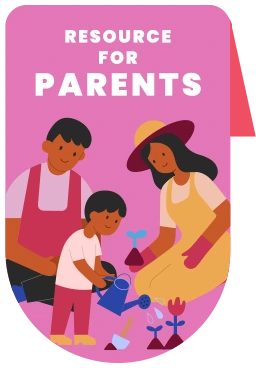Ms Joyce Teo, the 2023 ECDA Outstanding Preschool Educator Award winner and current vice principal of Little Skool-House (Kent Vale), encourages parents to involve their children in outdoor play and exploration. Her perspective on this was influenced by a study trip to Little Urban Forest (LUF), a preschool in Kuala Lumpur, Malaysia. LUF’s curriculum revolves around Forest School principles, which promote play-based, child-directed learning in natural settings.
Ms Teo shares four takeaways with parents.
 Ms Joyce Teo joins children in spontaneous play with nature objects found outdoors.
Ms Joyce Teo joins children in spontaneous play with nature objects found outdoors.
FOLLOW YOUR CHILD’S LEAD
Provide basic tools like pots and scoops, but let outdoor play be spontaneous and unstructured. Instead of telling children how to play, focus on looking out for their safety, stepping in when they need help and offering encouragement.
Take a cue from Ms Teo, who turned an outdoor walk into an impromptu mud play session. “The children picked up sticks and leaves and had fun playing with mud,” she recalls. “Some didn’t like getting dirty, but they learned that they could simply wash away the mud afterwards. They learned to step out of their comfort zone.”
CHANGE YOUR MINDSET ABOUT RISKS
Remind yourself that risk is an essential part of growing up. Risky play boosts children’s physical and motor skills, teaches them to manage fear and anxiety, and allows them to explore their boundaries and test their limits.
“The trip opened my eyes to the benefits that can come from risk-taking when children are outdoors,” says Ms Teo. “Initially, it was challenging not to say things like ‘be careful’, ‘come down’ or ‘don’t jump’ to the children. I had to embrace risk-taking and respect their choices.”
 By taking risks when playing outside, children can challenge themselves and acquire new skills.
By taking risks when playing outside, children can challenge themselves and acquire new skills.
TEACH CHILDREN HOW TO BE SAFE
Rather than avoiding anything that seems risky, it is better to keep a watchful eye on children and impart safety tips to them. For example, if your child wants to climb a tree, tell them to always have at least three bodily points of contact with the tree. If they want to jump from a height, check that it is age-appropriate and show them how to land safely.
Should your child fall, Ms Teo stresses that it is part of their development. “Children need to fall to learn how to pick themselves up. They will then keep trying and problem-solve until they are successful. Such experiences build resilience and confidence.”
MIND WHAT YOU SAY
Your choice of words influences how your child thinks and acts. “I stopped saying ‘be careful’ out of context,” says Ms Teo. “When we overuse this phrase, it stops children from trying new things because they are afraid it might be dangerous.”
She adds, “When I started saying ‘yes’ more, the children showed more confidence.” With safety measures in place, children can benefit from taking risks.








